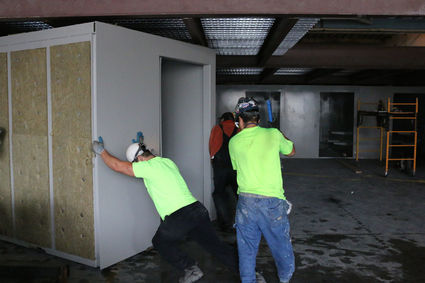Petersburg Police Department facility starting to take shape
The municipal building renovation project is coming along, and a cornerstone of the finished project will be the new facility for the Petersburg Police Department. Last month, steel jail cells were shipped up from Colorado, putting the facility one step closer to completion.
"It looks pretty good," says Chief Kelly Swihart. "I think we have it set up in a way
that's really going to ensure safety for inmates and employees."
Swihart classifies the old cells as "fairly secure, but I wouldn't say they were safe." The cells had exposed bars, allowing inmates the opportunity to grab department employees or officers. They also created a potential suicide risk, something that's always in the forefront of safety concerns, because of the bars running across them.
"There's a structure there that they could tie a sheet, or a cord or belt to and hang themselves," Swihart says. "All that's taken care of with the new cells."
Awhile back, a department employee fell while taking inmates food. It's not certain whether the employee slipped or tripped, but it resulted in them being within arm's reach of inmates.
"Those sorts of things have been alleviated, I hope, or at least mitigated for the most part," Swihart says.
Chief Swihart says the planning process for the design of the renovation ran into some structural constraints with load bearing walls while working with an architect and subcontractor placing some limitations on the design of the renovation because of the way the building is situated, but PPD ultimately got what they wanted.
"We wanted to maintain our current 12-bed capacity, we wanted to be able to separate males and females, and adults and juveniles," Swihart says. "Worst case scenario, we need to be able to separate male and female adults, and male and female juveniles. So we came up with a six-cell layout that would allow us to do
that."
Two of the cells are pass-through cells, which would normally be considered temporary holding cells without showers between the secure garage, also called a "sally port," and booking station. Along with the two pass-through cells, there is a larger cell compliant with the Americans with Disabilities Act. The cell is wheelchair accessible and has enough room for an occupant with disabilities to move freely in the cell.
The three cells are in a secondary cell block, with the three remaining cells making up the main cell block. In the main cell block there's even a couple feet of space for the inmates to stretch their legs, if they are behaving, and collect their meals.
"Those will be the three cells we typically use the most often," Swihart says. "Most of our inmates are adult males, so that's where the majority of those people will be held."
In regards to prefabricated cells, Swihart says they were just easier and made sense. Swihart points out they have quickly become a new industry standard down south. According to Corey Wall, the architect on the project, the six prefabricated steel jail cells cost $220,000 all together.
Swihart says PPD employees are looking forward to having a clean, safe, professional work environment.
"I think they are really excited," he says. "This building is old and definitely outlived its useful life. I think Petersburg got its money's worth out of this current facility."
For Jay Seavy, president of Maximum Security Systems (MSS), his journey in correctional facility construction started with building small county jails from concrete in the mid-80s. During that time, the steel cell industry was less than two percent of all jails and prisons being built in the United States. Today he says, that number's closer to, if not more than half.
In the mid-90s, Seavy started to see the benefits of building steel cells, rather than precast concrete. He acquired a company already manufacturing a steel cell, improved the product and began turning out his product. Seavy's patented the design and he's been selling them ever since.
"You have to paint a concrete cell, about every, at the least, minimum every two years."
An MSS steel cell is easy to clean as well, all that is required is spraying some Lysol and grabbing a hose to wash them out. The cost of the cell is also very appealing. A steel cell is produced and shipped much cheaper than a concrete masonry unit.
Seavy was in town to oversee the cells being put in place where they'd eventually be installed. The process was quick, lasting a little over a day. But it also gave Seavy a chance to experience Southeast.
"Well, I'll tell you what, we're from Colorado," he says starting to chuckle. "And we thought this is where God took all of his vacations, but I think that he may be going up to Petersburg occasionally too."












Reader Comments(0)